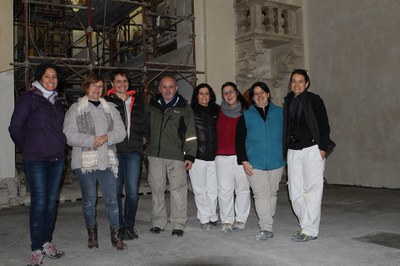Cultural heritage: laser technologies, a new frontier in restoration
28/4/2016
Restoring to life a 16th-century fresco using laser technologies. That’s what’s happening in a church on the outskirts of Viterbo (Italy), where ENEA researchers are using technologies derived from nuclear research - the new frontier for the conservation of artistic heritage- viewed with great interest by restorators.
Derived from nuclear research, laser technologies are the new frontier for the conservation of cultural heritage. An innovative application which is steadily gaining ground among those working in the field, particularly restorers, since it offers concrete prospects and solutions.
 ENEA, with eight diagnostic and two restoration technologies, has decided to open its laboratories to those companies committed to safeguarding and valorizing cultural heritage and take expertise and state-of the-art instruments to the restoration site. All this thanks to the COBRA project, that ENEA was awarded with an over 860 thousand euro grant by the Lazio Region for the transfer of advanced technologies and the creation of new jobs for young science graduates.
ENEA, with eight diagnostic and two restoration technologies, has decided to open its laboratories to those companies committed to safeguarding and valorizing cultural heritage and take expertise and state-of the-art instruments to the restoration site. All this thanks to the COBRA project, that ENEA was awarded with an over 860 thousand euro grant by the Lazio Region for the transfer of advanced technologies and the creation of new jobs for young science graduates.
It will be first put to the test in the 16th century Church of San Costanzo in Ronciglione- in the Tuscia area – on the fresco on the dome vault that, due to its poor state of conservation, can’t be completely restored using conventional mechanical and chemical techniques. “That’s why we have decided –Fernanda Falcon, the architect responsible for the restoration, pointed out- to start a collaboration with ENEA and carry out application tests of laser technologies. In this way we have been included in the project COBRA that will enable us to test technologies that could prove crucial to our case”.
“The RGB-ITR three -colour laser system developed at ENEA – Roberta Fantoni, Head of the Laboratory for Physical Technologies for Health and Safety, explained- has allowed us to obtain a three - dimensional model of the dome and natively acquire colour information, while accurately identifying the morphological characteristics of the surface itself.” Thanks to a 3D reconstruction it has been possible to detect cracks and flackings of the walls that hindered the removal of the layers covering the fresco, a mannerist circle of angels hymning and playing various instruments.
The LIF Scanning laser system – also for diagnostic imaging- has enabled us to obtain information on the materials contained in the superficial layer of the wall: from the distribution pattern of the consolidants used by the restorers in the presence of biodegrading or polluting agents.
“All this- the ENEA researcher said- thanks to our collaboration with EL.En Group, that has provided us with part of the laser tools of the project COBRA”. The results are encouraging. “ The shock waves created by the laser- Alessandro Zanini of El.En Group and President of Assorestauro, pointed out- succeded in stripping away the layers to be removed without damaging the one to be preserved. The restoration work is going to last a long time but one objective has already been reached : taking the technologies to the field, to the restorers. But there’s more. The professional team working at the church restoration will have the opportunity to conduct the laser cleaning operation autonomously, thanks to the instruments made available by ENEA and EL.En Group
For more information please contact:
Roberta Fantoni, ENEA Frascati Research Center, roberta.fantoni@enea.it
